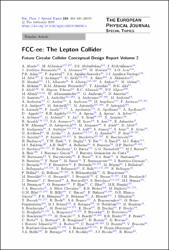| dc.contributor.author | Abada, A. | |
| dc.contributor.author | Abbrescia, M. | |
| dc.contributor.author | AbdusSalam, S. S. | |
| dc.contributor.author | Abdyukhanov, I. | |
| dc.contributor.author | Fernandez, J. Abelleira | |
| dc.contributor.author | Abramov, A. | |
| dc.contributor.author | Özdemir, Kadri | |
| dc.contributor.author | CMS Collaboration | |
| dc.date.accessioned | 2021-06-05T19:57:24Z | |
| dc.date.available | 2021-06-05T19:57:24Z | |
| dc.date.issued | 2019 | |
| dc.identifier.issn | 1951-6355 | |
| dc.identifier.issn | 1951-6401 | |
| dc.identifier.uri | https://doi.org/10.1140/epjst/e2019-900045-4 | |
| dc.identifier.uri | https://hdl.handle.net/20.500.12960/492 | |
| dc.description | WOS:000470784400001 | en_US |
| dc.description.abstract | In response to the 2013 Update of the European Strategy for Particle Physics, the Future Circular Collider (FCC) study was launched, as an international collaboration hosted by CERN. This study covers a highest-luminosity high-energy lepton collider (FCC-ee) and an energy-frontier hadron collider (FCC-hh), which could, successively, be installed in the same 100 km tunnel. The scientific capabilities of the integrated FCC programme would serve the worldwide community throughout the 21st century. The FCC study also investigates an LHC energy upgrade, using FCC-hh technology. This document constitutes the second volume of the FCC Conceptual Design Report, devoted to the electron-positron collider FCC-ee. After summarizing the physics discovery opportunities, it presents the accelerator design, performance reach, a staged operation scenario, the underlying technologies, civil engineering, technical infrastructure, and an implementation plan. FCC-ee can be built with today's technology. Most of the FCC-ee infrastructure could be reused for FCC-hh. Combining concepts from past and present lepton colliders and adding a few novel elements, the FCC-ee design promises outstandingly high luminosity. This will make the FCC-ee a unique precision instrument to study the heaviest known particles (Z, W and H bosons and the top quark), offering great direct and indirect sensitivity to new physics. | en_US |
| dc.language.iso | eng | en_US |
| dc.publisher | Springer Heidelberg | en_US |
| dc.relation.ispartof | European Physical Journal-Special Topics | en_US |
| dc.rights | info:eu-repo/semantics/openAccess | en_US |
| dc.subject | Fizik | en_US |
| dc.subject | Physics | en_US |
| dc.title | FCC-ee: the Lepton Collider: Future Circular Collider Conceptual Design Report Volume 2 | en_US |
| dc.type | article | en_US |
| dc.authorid | 0000-0002-0103-1488 | |
| dc.department | Mühendislik Fakültesi, Elektrik-Elektronik Mühendisliği Bölümü | en_US |
| dc.contributor.institutionauthor | Özdemir, Kadri | |
| dc.identifier.doi | 10.1140/epjst/e2019-900045-4 | |
| dc.identifier.volume | 228 | en_US |
| dc.identifier.issue | 2 | en_US |
| dc.identifier.startpage | 261 | en_US |
| dc.identifier.endpage | 623 | en_US |
| dc.relation.publicationcategory | Makale - Uluslararası Hakemli Dergi - Kurum Öğretim Elemanı | en_US |

















